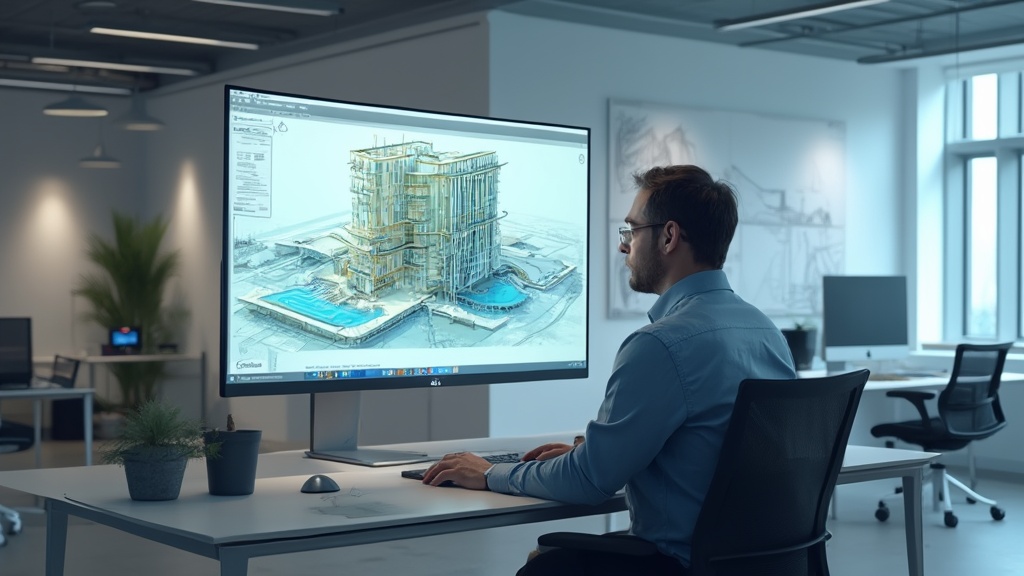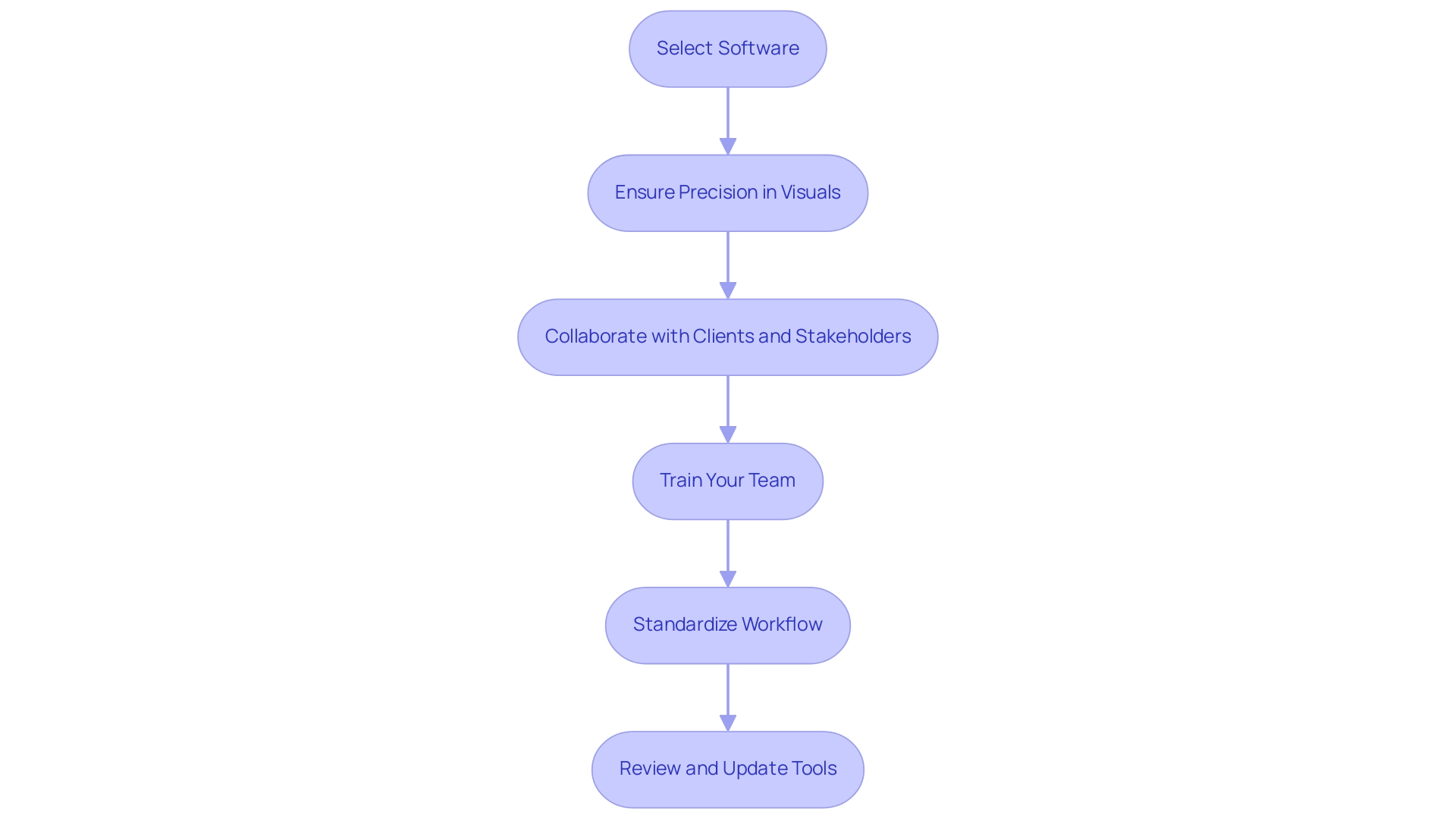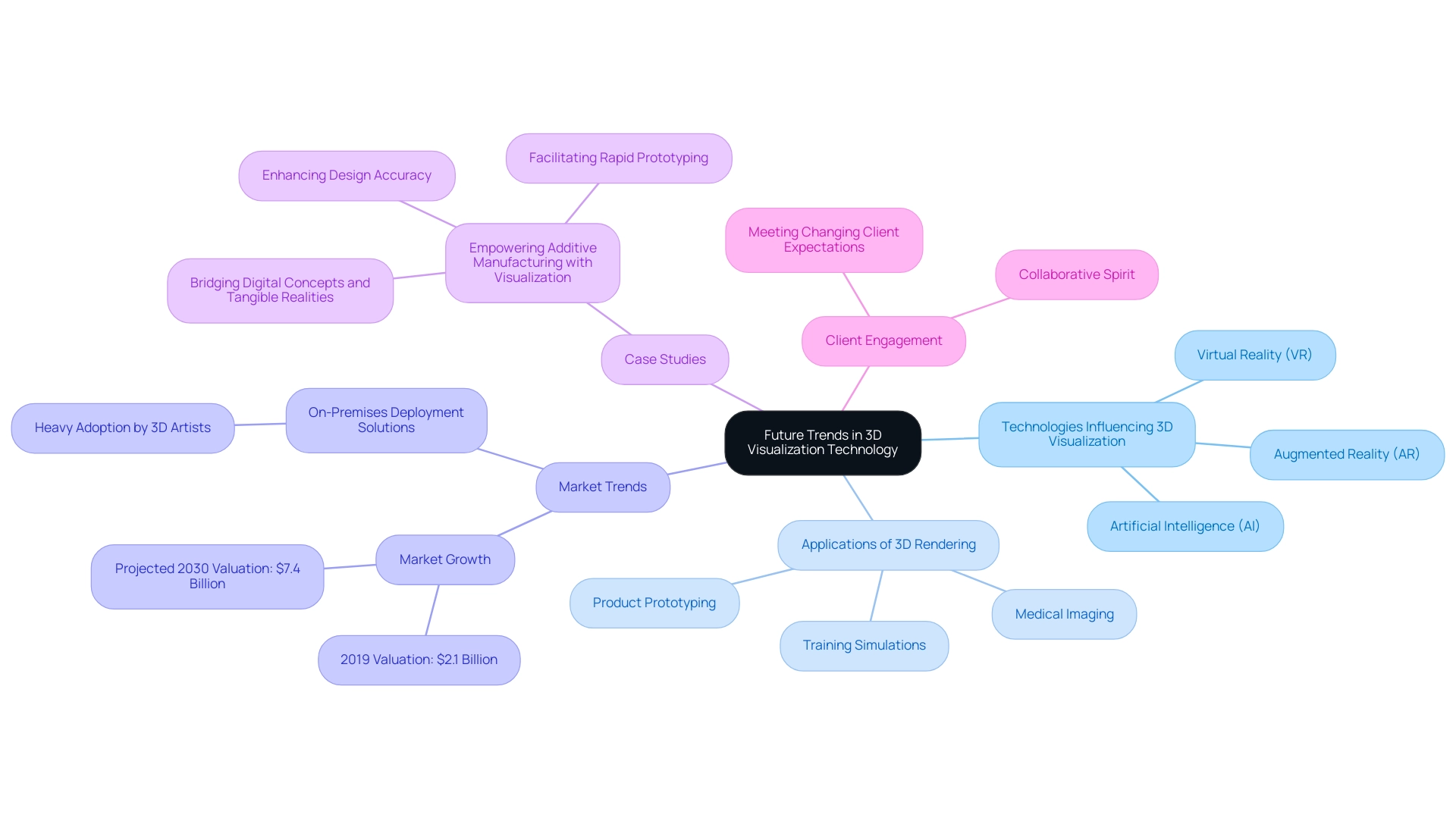Introduction
The evolution of architectural practice is increasingly intertwined with the advancements in 3D visualization technology, which offers architects and designers the ability to create compelling, realistic representations of their projects before they come to life. This sophisticated technique, enhanced by artificial intelligence, not only bridges the gap between concept and reality but also transforms stakeholder engagement by providing immersive, lifelike experiences.
As the demand for high-quality visualizations continues to rise, understanding the nuances of this technology becomes imperative for professionals aiming to leverage its potential effectively. From improving communication and collaboration to serving as powerful marketing tools, the applications of 3D visualization are vast and varied, underscoring its critical role in contemporary architectural practices.
As firms navigate the complexities of integrating these tools into their workflows, a thorough examination of best practices and future trends will illuminate the path forward in this dynamic field.
Understanding 3D Visualization: A Comprehensive Overview
3D visualisation solutions serve as an advanced technique that enables architects and designers to create highly realistic representations of their projects prior to construction. This method, improved by AI technologies that connect the uncanny valley, permits the creation of realistic CG humans that greatly enhance building representations. By utilizing advanced software and production techniques, design ideas are converted into engaging representations, allowing stakeholders to understand design intent with clarity.
The significance of lifelike CG humans resides in their capacity to introduce a relatable human aspect to building visuals, enhancing their engagement and realism. The uses of 3D visualisation solutions are diverse, ranging from straightforward presentations to intricate simulations that depict varying lighting conditions, textures, and materials, all of which enhance architectural decision-making. The role of pre-sales visualization is essential, as high-quality images provide a tangible asset that instills confidence in projects and can ignite interest and investment long before construction begins.
As emphasized in the case studies, these representations act as a bridge between concept and reality, empowering developers and stakeholders alike. This trend is reflected in the growing outsourcing of 3D visualisation solutions, indicating an increasing reliance on these technologies. With the adoption of 3D visualisation solutions projected to rise further in 2024, understanding its fundamentals is critical for architectural professionals.
Recent statistics indicate a significant rise in the adoption rate of 3D visualisation solutions in architecture, underscoring their importance in contemporary practice. Furthermore, insights from the recent article ‘Beyond Photorealism: Blending Art, Data, and Emotion in Real-Time Architectural Visualization’ by Monica Nelson provide valuable perspectives on the latest advancements in this field. This knowledge not only aids in the incorporation of these technologies into workflows but also enables architects to utilize graphical representation as a strategic tool that drives project success and enhances stakeholder engagement.
The Advantages of Implementing 3D Visualization Solutions
Implementing 3D visualisation solutions in architectural projects yields significant advantages, primarily through enhanced communication and collaboration among stakeholders. By representing layouts in three dimensions, architects can articulate complex concepts with clarity, thereby minimizing misunderstandings and reducing the necessity for revisions. Notably, research indicates that utilizing visuals can lead to an impressive 80% decrease in errors when explaining tasks.
This enhancement in communication is essential, as it permits real-time adjustments and feedback, effectively expediting the development process. Client testimonials at J. Scott Smith Visual Designs emphasize the significant effect of these graphics; one client remarked, ‘The 3D images assisted us in imagining the project in a manner we never considered achievable, resulting in an easier approval process and increased confidence in our choices.’ Another client shared, ‘Observing the detailed interior visuals enabled us to make essential choices early on, ultimately saving us time and money.’
These affirmations underscore that the ability to visualize the final product accurately is invaluable. Additionally, 3D representations serve as compelling marketing tools, enabling firms to present their designs in an engaging manner that resonates with potential clients. As emphasized in case studies like ‘The Power of Pre-Sales Visualization,’ 3D visualisation solutions are instrumental throughout various stages of a project, from concept development to marketing, facilitating clearer communication and attracting prospective buyers.
Furthermore, detailed interior renderings contribute significantly to showcasing functionality and aesthetics, enhancing client satisfaction and marketing effectiveness. In conclusion, as mentioned by Marcelo R. Campo of UNICEN-CONICET,
Finally, we conclude identifying future research directions,
highlighting the ongoing development and influence of 3D representation in design practices and client satisfaction. Authored by Raja Antony on November 4, 2023, this article highlights the transformative potential of 3D representation in enhancing project communication and client engagement.
Best Practices for Integrating 3D Visualization Tools
To effectively integrate 3D visualisation solutions into design projects, it is crucial to begin with a meticulous selection of software that aligns with your firm’s specific needs and workflows. Leading options in 2024 include:
- SketchUp
- Revit
- Lumion
Each offering unique capabilities tailored for various project types. For instance, SketchUp excels in ease of use for conceptual planning, while Revit is preferable for BIM applications due to its robust data management features.
Lumion, conversely, is famous for its speed in creating images and visual realism, making it perfect for engaging client presentations.
Furthermore, ensuring precision in visuals requires meticulous attention to detail, especially in the small elements that contribute to the storytelling aspect of architectural designs. Effective collaboration with clients and stakeholders enhances this process, as it aids communication with builders, lenders, municipalities, and other interested parties. The integration of advanced 3D modeling software provides 3D visualisation solutions that allow for customized concept visualizations, meeting specific project needs and enhancing clarity and communication across various parties involved in the project.
As noted, 3D townhome rendering empowers developers by equipping them with a compelling narrative—one that not only sells homes but also illustrates the future of their developments.
Furthermore, effective data representation requires software that can engage with data, clean and prepare it properly, and incorporate powerful tools like D3. Equipping your team with comprehensive training on the selected software is essential to fully leverage its features and capabilities. Following the philosophy that all creative choices must serve the purpose of creating a deliverable that is well received and easily understood by the reader is vital in 3D visualization.
A standardized workflow that incorporates these tools at every stage—from initial concepts to final presentations—will significantly enhance the quality and impact of your designs.
Additionally, it is imperative to regularly review and update your tools and workflows. Keeping up with technological progress, like the examination of solar radiation and precipitation data, not only improves your creative process but also guarantees your company stays competitive in the fast-changing built environment. Incorporating interactive visualizations, as seen in recent assessments of floodwall vulnerabilities, illustrates the potential of these tools to convey complex data effectively.
By following these best practices and consistently improving your method, you can enhance the accuracy and intricacy of your presentations, making a persuasive argument for your concepts. Reach out today to discuss how we can assist in bringing your architectural visions to vibrant life.
Industry Applications of 3D Visualization Solutions
The scope of 3D visualisation solutions extends well beyond the architecture sector, finding critical applications in:
- Real estate
- Urban planning
- Interior design
In the realm of real estate, utilizing 3D visualisation solutions in marketing materials can attract more potential buyers and increase closed deals. Virtual tours created through 3D visualisation solutions enable potential buyers to explore properties remotely, thus streamlining the sales process and significantly enhancing buyer engagement.
This approach not only attracts more potential buyers but also contributes to an increase in closed deals. As Malgo Widaj, founder and owner of RNDR, notes, ‘Now RNDR teams are assisting product designers, architects, and developers worldwide to enhance visual communication through storytelling images, improve media presence, win project competitions or boost sales through visualization experiences.’
In urban planning, sophisticated 3D visualisation solutions are used to visualize the implications of new developments on existing environments, fostering meaningful community engagement and soliciting valuable feedback from stakeholders.
Furthermore, interior designers utilize 3D visualisation solutions to craft immersive environments, allowing clients to experience various styles and layouts prior to any physical alterations. Our collaborative rendering process at J. Scott Smith Visual Designs includes detailed steps such as:
- Detail Modeling, where our skilled artists meticulously craft a 3D model
- Material & Lighting Selection, which ensures that materials reflect design intent and create a realistic visual experience
This process ensures that we provide 3D visualisation solutions with detailed models that exceed client expectations and enhance the emotional impact of architectural visions.
A case study emphasizing the significance of 3D representations for small architecture firms demonstrates that high-quality images result in enhanced success in obtaining projects. As one satisfied client stated, ‘The renderings transformed our vision into reality and helped us secure funding.’
These diverse applications highlight the adaptability and essential role of 3D visualisation solutions in contemporary project contexts, making them an invaluable asset across multiple disciplines.
Future Trends in 3D Visualization Technology
As we advance into 2024, the realm of 3D visualization is profoundly influenced by the integration of cutting-edge technologies such as artificial intelligence (AI), virtual reality (VR), and augmented reality (AR). These innovations are not just supplementary to building practices; they are fundamentally reshaping client interactions with creations by providing immersive experiences that facilitate a deeper engagement and comprehension of spatial concepts. Notably, the market continues to lean towards on-premises deployment solutions, favored by 3D artists for their superior control and performance.
Moreover, real-time visualization technologies are swiftly advancing, enabling architects to make immediate changes based on client input, thus improving collaboration and responsiveness in the creative process. The use of AI is especially remarkable, as it plays a crucial part in creating realistic CG humans and enhancing workflow processes, effectively closing the uncanny valley that frequently poses challenges for architectural representations. This trend is evident in the growing 3D imaging and display software market, which increased from a valuation of $2.1 billion in 2019 to an expected $7.4 billion by 2030.
Beyond architecture, 3D rendering finds diverse applications in fields such as:
- Medical imaging, where it aids in visualizing complex anatomical structures
- Training simulations, which provide realistic scenarios for skill development
- Product prototyping, enabling rapid iteration and testing of concepts
A compelling example of 3D representation’s impact can be found in the case study titled ‘Empowering Additive Manufacturing with Representation,’ which shows how effective depiction links digital concepts to physical realities, enhancing creation accuracy and facilitating rapid prototyping. For architects committed to maintaining a competitive edge, staying informed about these advancements is essential.
Adopting these technologies not only enhances the quality of design results but also fulfills the changing expectations of clients who increasingly seek advanced and interactive 3D visualization solutions. As emphasized by CG Viz Studio, ‘Ready to elevate your project with cutting-edge 3D visualization? Let’s collaborate and bring your vision to life.’
This call to action encapsulates the collaborative spirit vital for leveraging these advancements in the architectural field, particularly at J. Scott Smith Visual Designs, where client satisfaction is paramount.
Conclusion
The integration of 3D visualization technology into architectural practices has transformed the landscape of design and stakeholder engagement. By enabling architects to create realistic representations of their projects, this technology not only enhances communication but also significantly reduces errors, streamlining the design process. The case studies and testimonials provided illustrate the tangible benefits of 3D visualizations, affirming their role as essential tools in both marketing and project development.
Implementing best practices for 3D visualization—such as selecting the right software, ensuring accuracy, and fostering collaboration—can elevate the quality and effectiveness of architectural presentations. As the industry continues to evolve, staying abreast of technological advancements and adapting workflows to incorporate these innovative tools will be critical for maintaining a competitive edge.
Looking forward, the intersection of 3D visualization with AI, VR, and AR promises to further enrich client interactions and enhance the overall design experience. As the market for these technologies expands, architects and designers must embrace these trends to meet the increasing demand for immersive and interactive visual solutions. Ultimately, the effective use of 3D visualization stands as a cornerstone of modern architectural practice, driving project success and fostering deeper connections with all stakeholders involved.






0 Comments